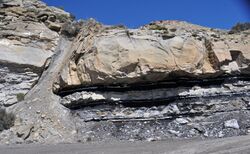Tonstein
Topic: Earth
 From HandWiki - Reading time: 2 min
From HandWiki - Reading time: 2 min
Tonstein (from the German "Ton", meaning clay, plus "Stein", meaning rock) is a hard, compact sedimentary rock that is composed mainly of kaolinite or, less commonly, other clay minerals such as montmorillonite and illite. The clays often are cemented by iron oxide minerals, carbonaceous matter, or chlorite.[1][2] Tonsteins form from volcanic ash deposited in swamps.[3] Tonsteins occur as distinctive, thin, and laterally extensive layers in coal seams throughout the world. They are often used as key beds to correlate the strata in which they are found. The regional persistence of tonsteins and relict phenocrysts indicate that they formed as the result of the diagenetic alteration of volcanic ash falls in an acidic (low pH) and low-salinity environment, consistent with a freshwater swamp.[3][4] In contrast, the alteration of a volcanic ashfall deposit in a marine environment typically produces a bentonite layer.[3]
The induration of tonsteins is in contrast to kaolin claystones that can be mined for kaolin clay, such as the ball clays found at Bovey Tracey which formed by the erosion of a nearby kaolinised granite. These deposits are generally softer, white, and plastic.[5]
See also
- Earth:Lutite – Old terminology for clayey sedimentary rock
- Earth:Pelite
- Chemistry:Shale – Fine-grained, clastic sedimentary rock
References
- ↑ "Tonstein" (in German). Litholexikon. Chemikus-Web. http://www.chemikus.de/litholexikon/tonstein.htm.
- ↑ "Tonstein" (in German). Die Welt der Gesteine. Geowissenschaftlicher Dienst, Dr. Olaf Otto Dillmann. http://www.geodienst.de/tonstein.htm.
- ↑ 3.0 3.1 3.2 Potter, P. E., J. B. Maynard, and P. J. Depetris (2005) Mud and Mudstones Springer-Verlag, Heidelberg, Berlin. 297 pp. ISBN:3-540-22157-3. pp. 141–142.
- ↑ Bohor, B. F., and D. M. Triplehorn (1993) Tonsteins: altered volcanic ash layers in coal-bearing sequences Special Paper 285. Geological Society of America, Boulder, Colorado, 44 pp. ISBN:9780813722856
- ↑ Selley, R,C (2000). Applied Sedimentology (2 ed.). Elsevier. pp. 337. ISBN 9780126363753. https://books.google.com/books?id=k3PnTbjR0DMC&q=tonstein&pg=PA339. Retrieved 28 December 2012.
External links
- R. A. Batchelor, Bentonite & Tonstein Bibliography, St. Andrews University
 |
 KSF
KSF
